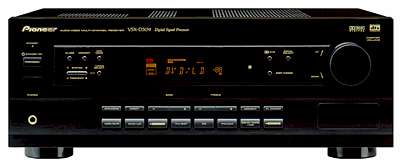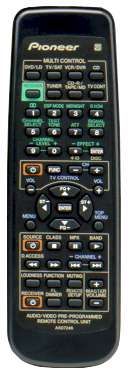 |
 |
Quick Takes - Pioneer
VSX-D309 Dolby Digital/DTS Receiver
Jared Baldwin
| Ratings: | ||
| Extraordinary | ||
| Good | ||
| Acceptable | ||
| Mediocre | ||
| Poor |
![]()
Pioneer VSX-D309 Dolby Digital/DTS Receiver
 |
 |
60 watts x 5 (DD and DTS)
Inputs: 1
Optical Digital, 1 Coaxial Digital, 3 audio, 3 video
Outputs: 1
S-Video, 1 Composite Video
Universal Remote Control
MSRP- $325
What they say:
Pioneer has been at the forefront of home theater receiver
technology including the first Dolby Pro Logic A/V receivers and next
generation AC-3 A/V systems. The
Pioneer VXS-D309 has included both Dolby Digital and DTS decoding capabilities,
so you don't have to choose which leading format to listen to.
With Pioneer's leading technology you get crisp onscreen dialog and
booming digital effects from today's DVD movies and soundtracks.
In addition, the S-Video allows you to take advantage of one of the top
video signals now available. In
similar fashion, the Pioneer VSX-D309 has one optical digital and one coaxial
digital input to receive the highest quality audio from any digital source.
What we found:
The Pioneer VSX-309 is definitely toward the bottom rung when
considering price of DD and DTS receivers, but does that necessarily mean that
it lies on the bottom when you consider performance?
In 2-channel stereo mode, music was powerful and clean, with maybe even
a little power left in reserve. The
VSX-309 has the usual DSP modes, although not all of them are equally useful.
I found that a flat bass response at 0 dB and +2 dB for the treble gave
the best overall sound for the DSP modes when playing music. On the other hand, when switching over to DD and DTS modes,
the VSX-309 started to show the limitations of its amplifier.
At 60 watts per channel, this receiver may seem a little on the
underpowered side for large and even some medium sized rooms, but will fill small rooms with
plentiful sound. The digital inputs are great when hooking up sources such as a DVD
player or a digital satellite, and true to form, the sound is noticeably
improved when using these inputs.
Some may find that the small buttons on the remote and the fact that it has no back lighting make the remote hard to use. This can be easily remedied by soft lighting in the room during night movie watching. The volume indicator on the face of the receiver would have been well served if it were as big as the rest of the display, which is much easier to read. The S-Video output would have been a lot nicer if it had more than one S-Video input, meaning there is no S-Video switching. In reality, it only forces you to have to run another S-Video connection from the receiver to your video monitor instead of running the S-Video direct from its source. The VSX-309 runs cool for a receiver so you could even stack other components atop it if needed (with some spacers). Be sure to shop around, and you can find this receiver in the low $200 range.
Rating:
| Looks: | |
| Sound: | |
| Build: | |
| Ease of Use: | |
| Value: |
- Jared Baldwin
![]()
© Copyright 2000 Secrets of Home
Theater & High Fidelity
Return to Table of Contents for Quick Takes
Go to Home Page